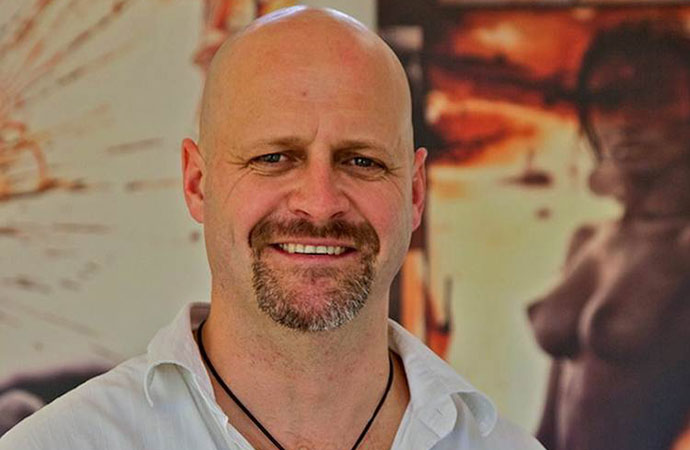Chef Bruce Robertson’s Scarborough restaurant-from-home is attracting a happy following for deliciously relaxed lunches using simple, sustainable seafood.
Kim Maxwell
The Boat House, 36 Beach Road, Scarborough. Call 021-780-1789 or visit www.chefbrucerobertson.com.
It’s a crisp salt-tinged day in Scarborough, a quiet coastal village near the tip of the Cape Peninsula, overlooking the Atlantic Ocean. A white clapboard double-storey has two tables set for lunch and we’re having a celebratory glass of vintage Cederberg Brut MCC. Chef Bruce Robertson is doing the cooking, wine and serving. He’s an old hand on the South African food scene but this is something different. We’re eating in his home.
An art director who decided to switch professions while cycling around Europe, Bruce earned his whites in good restaurant kitchens. He cheffed in the bush at Singita Boulders luxury game lodges, managed the Cape Grace luxury hotel as executive chef and ran his own Cape Town restaurant, The Showroom. Anybody who has dined within earshot of Bruce will know that visually exciting food and an exuberant personality are par for the course. When he cooks you feel his creative energy, and smile frequently at the verbal quips that are his condiments.
The Boat House’s intimate seating means you chat to other diners over lunch. Today’s guests include a film casting agent from Los Angeles and her son, who is in film production in New York. They have a thing for tasting menus, so they’re excited about trying The Boat House five-course seafood menu. It includes an extra seafood dish and a local cheese platter, in addition to the three-course chowder starter, fishy main and Cape dessert. Bruce is outlining the menu while pin boning gurnard fillets.
The Boat House chowder starter introduces fish stock-infused salty flavour with angelfish pieces, peas, baby marrows and mussel meat. Homemade gnocchi grounds the dish, with a spicy tomato and citrus lift brought in by the bisque and chorizo slices. The genius is in the hot ingredients pulling together against the cold olive oil-and-lemonmarinated grated fennel bulb salad.
“Today you’re eating Brama brama in The Boat House chowder. That’s angelfish, kids!” Bruce may be goofing around with the scientific pronunciation, but he’s serious about only serving SASSI green fish. “I buy filleted fish from Sylvia’s Fish Market at Kalk Bay harbour daily; she sells me small quantities of Thyrsites atum [snoek].”
Excellent Cederberg wines (dry sauvignon blanc and rosé, plus off-dry bukettraube) and a vintage bubbly are on offer with the five-course option, while one glass accompanies the threecourser. Bruce pours himself a glass and answers questions while he cooks. “I’m eating, drinking and cooking for fun now. Cooking is more than a passion, it has become a lifestyle,” he explains. “I buy only what I need, which is why my reservation rule is 24 hours in advance.”
This is a one-man show, with only a Malawian assistant helping to clean the small domestic kitchen. It means less lunch guests and less hassle, so the chef has more time to enjoy his surroundings. He regularly takes his mountain unicycle out for a spin.
So why does lunch seem so effortless? Bruce preps the night before, and knows his way around a kitchen. “A lady from
Sweden was so impressed with my food, she didn’t believe I’d made it all here. She asked to check the ingredients in my fridge,” he laughs.
The menus are based around sustainable seafood and seasonal ingredients. Bruce bakes mini bread loaves to start, grows his own herbs, and sources goat’s or cow’s milk cheeses (served with a chilli bite and homemade black fig chutney) locally from Imhoff Cheesery, about 12km away.
Seared gurnard fillet is our tasty main course, with a piped swirl of olive oilmashed potato, perky green beans and a poached quail egg on wilted spinach – the warm Niçoise part of the dish. It’s deceptively simple because flavours dance, thanks to chilli tomato and olive chutney, salty caperberry, a drizzle of pesto and a lavash biscuit. His flair shows in a strip of nori seaweed with holes cut out with a paper punch. The seaweed ‘confetti’ was dusted over the chowder starter.
Dessert has Cape overtones: Bruce’s melkkos boeber jelly incorporates the traditional Cape Malay milky cinnamonlaced boeber pudding set with vermicelli and sago in a creamy panna cotta, topped with crushed meringue, bee pollen and vanilla ‘frozen cream’ (ice cream). Alongside – a stewed fruit samoosa, mini malva pudding with lemon cream and a dash of Nachtmusik. It’s tasty and fun.
There is also a sleepover option, where guests go off for picnics or walks, and share Bruce’s home with him and four-year-old daughter Jemima. The entertaining space is dotted with cookbooks and art, wine boxes, restaurant award certificates and treasured family photographs. A warthog skull from Sabie, a leopard skull from the Orange River
and a kudu horn from the Eastern Cape provide talking points for tales about the bush. The chef closes the restaurant to take regular jaunts to luxury safari lodges in southern Africa, moving between different camps where he woos small groups of VIP customers with his gourmet cooking and wines.
But The Boat House is his base. “I wanted to capture a market where people are looking for this [he opens his arms towards the sea]. Between Cape Point and Noordhoek there’s The Foodbarn and us,” says Bruce. “I want to be here for a while. The Boat House is a five-year project at least.”
We’re all completely sold on this simpler seafood-focused eating experience. A series of honest dishes prepared with skill, pared down to flavour and texture essentials. It isn’t complicated but relies on layering of flavour through sauces, chutneys or contrasting of, say, raw fennel bulb salad with pan-seared gurnard. Of all his cooking, this frankness on a plate is what I’ve liked best. The restaurant opened in February 2012. A framed piece of wall with scribbled comments from happy guests is already full.
SOURCES
Bruce Tuck

